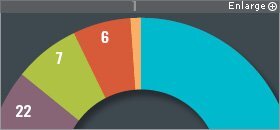Charter, virtual, and alternative schools account for a disproportionate share of U.S. high schools with low graduation rates, according to a new study. Even though they enroll only a small slice of students, they account for more than half of the U.S. high schools that graduate 67 percent or less of their students in four years.
Released last week, the “Building a Grad Nation” report concludes that regular district high schools make up 41 percent of the schools that didn’t surpass the 67 percent graduation threshold in 2013-14. Charter, virtual, and alternative schools—a small sector, representing only 14 percent of the country’s high schools and 8 percent of its high school students—account for 52 percent of the schools that fell short of that mark. (The remaining 7 percent are vocational and special education schools.)
The report, the seventh in an annual series on graduation rates, offers a challenge to a country that’s renewing its focus on graduation rates through the newly revised Elementary and Secondary Education Act. Known as the Every Student Succeeds Act, the law requires states to report graduation rates for schools that enroll 100 students or more, and districts to provide research-based help for schools with graduation rates of 67 percent or less.
Expanding the Pool
“Building a Grad Nation,” the latest in a series of annual reports about high school graduation rates, finds that charter, alternative, and virtual schools contribute a disproportionate share of the high schools that graduate 67 percent or less of their students in four years.

Source: Civic Enterprises, Everyone Graduates Center
With that new law in mind, the organizations that issue the “Grad Nation” reports—Civic Enterprises, the Everyone Graduates Center at Johns Hopkins University, the Alliance for Excellent Education, and the America’s Promise Alliance—shifted the focus of this year’s report, from schools that enroll 300 or more students (about 13,400 schools) to those that enroll 100 or more (about 18,100 schools).
That change nearly tripled the scope of the study of schools with low graduation rates, from 1,000 schools to 2,397. In a foreshadowing of the work that states face under ESSA, the Grad Nation researchers looked for patterns among the schools with low graduation rates.
The contrast between “regular” district high schools and alternative, virtual, and charter schools showed the starkest pattern. Regular high schools made up 84 percent of the schools, but 4 in 10 of the schools with low graduation rates. Charter schools represented 8 percent of the schools, but 22 percent of those with graduation rates of 67 percent or lower.
The Grad Nation researchers called attention to the preponderance of low-grad-rate schools among charter, alternative, and virtual schools because their numbers have been rising in the last 15 years, and because they enroll large shares of low-income, black, and Hispanic students. The high number of alternative schools with low graduation rates in some states might signal that some states “are relying a little too much on the idea that when kids struggle, the best solution is to send them to another school” rather than provide stronger supports in their own schools, Robert Balfanz, the co-director of the Everyone Graduates Center, told reporters in a conference call.
Differences Among States
State variability is a key force in the national numbers of schools with low graduation rates, Balfanz said. In Alaska, New Mexico, and Florida, 30 percent or more of the high schools have graduation rates of 67 percent or lower.
In each sector of schools analyzed, particular states stood out for their large shares of schools with low graduation rates, too. Of all the low-graduation-rate schools in Hawaii, 100 percent were charters. In Arizona, the proportion was 73 percent. Kentucky, Texas, and Washington topped the list of states with especially high shares of alternative schools with low graduation rates.
But in some states, the charter sector is “helping solve the dropout crisis” by running many schools with good graduation rates, Balfanz said. He pointed to New York, New Jersey, Massachusetts, and Oklahoma as examples.
Nina Rees, the president of the National Alliance for Public Charter Schools, said the report made the charter sector’s graduation rates look worse than they are because it didn’t adequately remove alternative schools from the sector. She pointed out that the study found that more than 4 in 10 charter schools have graduation rates of 85 percent or more.
Last December, many celebrated when the nation’s high school graduation rate reached an all-time high of 82 percent for the class of 2014. But the milestone also sparked skepticism about whether states or districts were using shortcuts to boost their diploma numbers, by lowering academic expectations or changing they way they counted transfer students in each class cohort.
The Grad Nation researchers took on those questions, and concluded that there was little or no evidence that such practices were affecting state-level graduation rates. Further analysis would have to be done to make such conclusions at the district level, the report says. It did not examine schools’ increasing reliance on credit-recovery programs to improve graduation rates.
The Every Student Succeeds Act gives states increased autonomy over how they handle low-performing schools. The Grad Nation authors urge states to give graduation rates significant weight in their accountability systems, and to make sure that charter, virtual, and alternative schools, as well as traditional high schools, are monitored and provided solid help to address graduation rates.
They also urge states to report five- and six-year graduation rates, to capture a more accurate picture of diploma-earning. Many alternative schools, in particular, were created to serve students who struggled in traditional schools, and who might take longer to earn their diplomas, the report notes. Adding five-year graduation rates to the national picture would boost the rate by 3 percentage points, it says, and adding six-year rates would increase it by another point.





